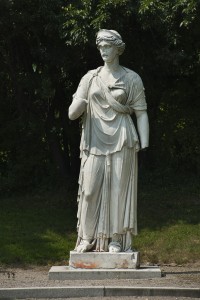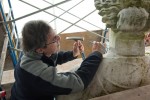 A colossal Roman statue of Juno was lowered through a dismantled skylight in the roof of the Italian Renaissance Gallery in Boston’s Museum of Fine Art (MFA) on Tuesday. She’s 13 feet tall including her plinth and weighs 13,000 pounds, making her the largest Classical marble statue in North America. She was purchased for the MFA by an anonymous donor last year, but her enormous size and delicate condition required a great deal of study before she could be moved.
A colossal Roman statue of Juno was lowered through a dismantled skylight in the roof of the Italian Renaissance Gallery in Boston’s Museum of Fine Art (MFA) on Tuesday. She’s 13 feet tall including her plinth and weighs 13,000 pounds, making her the largest Classical marble statue in North America. She was purchased for the MFA by an anonymous donor last year, but her enormous size and delicate condition required a great deal of study before she could be moved.
Juno’s dating is uncertain. We know she’s from the early Imperial era, probably from the reign of Trajan or Hadrian in the early second century A.D. Her first appearance in the historical record is in the 1633 inventory of the famed Ludovisi Collection, an immense collection of art and antiquities collected by Cardinal Ludovico Ludovisi and his uncle Alessandro Ludovisi, aka Pope Gregory XV. Some of the works they purchased, and others, some of the most famous, Cardinal Ludovisi found during construction of his stately pleasure dome.
In 1622 Cardinal Ludovisi bought some vineyards in what was then a suburb of Rome and built the Villa Ludovisi, various smaller buildings, and elaborate gardens on the grounds. Those vineyards turned out to have once been the Gardens of Sallust, a vast garden of renowned beauty built in the first century B.C. by Roman historian Sallust on property that once belonged to Julius Caesar. Subsequent emperors claimed the gardens which were maintained and open to the public until Alaric’s sack of Rome in 410 A.D. Workers building Ludovisi’s villa turned up an incredible bounty of ancient statuary, including the Dying Gaul.
Given Juno’s hugeness, it would make sense if she were one of the pieces discovered on the spot rather than one of the acquisitions. Then again, the obelisk in St. Peter’s Square was moved there in 1586 and that bugger is 83 feet tall and weighs 331 tons, so who knows? We do know that Juno remained on the grounds of the Villa Ludovisi where she was photographed in 1890.
A few years before that picture was taken, in 1885, Don Rodolfo Ludovisi, Prince of Piombino, heir to the Cardinal’s great patrimony, sold the villa and much of its property to real estate developers. They demolished everything, creating one of Rome’s toniest neighborhoods where the American Embassy now stands. (The embassy, btw, is housed in the Villa Margherita, built between 1886 and 1890 by that rat of a prince on a piece of Ludovisi land he hadn’t sold to developers. The costs of construction were so crippling that he couldn’t even afford to pay for it, so he ended up selling that villa too to the Italian state.)
 By 1893, the Boncompagni Ludovisi family was in dire financial straits. The next thing to go was one of the world’s greatest art and antiquities collections. Thankfully much of it was purchased by the state and is in Roman museums today, but in 1897 Juno was bought by Charles Franklin Sprague and his wife, Mary, of Boston. The statue was shipped to Boston first, then in 1904 carted by a team of 12 oxen to the Sprague’s estate in Brookline. It was the centerpiece of their Italianate garden for the next 107 years until it was purchased for the MFA.
By 1893, the Boncompagni Ludovisi family was in dire financial straits. The next thing to go was one of the world’s greatest art and antiquities collections. Thankfully much of it was purchased by the state and is in Roman museums today, but in 1897 Juno was bought by Charles Franklin Sprague and his wife, Mary, of Boston. The statue was shipped to Boston first, then in 1904 carted by a team of 12 oxen to the Sprague’s estate in Brookline. It was the centerpiece of their Italianate garden for the next 107 years until it was purchased for the MFA.
Living outdoors in Boston is very different from living outdoors in Rome, however, and that century plus of New England winters has been hard on Juno. Before she could be moved, conservators had to do an in-depth analysis of her condition using X-rays and ground penetrating radar to find her weaknesses. They also took samples of stone from various parts of her to determine which pieces are original to the statue and which were added in later restorations. A 3D laser scan of the entire statue helped conservators model the potential stresses of transportation.
 In December of last year, the MFA team, including structural engineers, stone masons and steel manufacturers as well as conservators, moved her to a storage unit. Their studies showed that her ankles, waist and neck were the salient weak points. The waist has a deep crack and the arm was attached with an iron bracket at some point after its Renaissance rediscovery. The head was also attached to the statue using adhesives and a thick iron pin, and the neck is so thin that simple vibrations from movement could have snapped the head right off. So stone masons snapped it off first.
In December of last year, the MFA team, including structural engineers, stone masons and steel manufacturers as well as conservators, moved her to a storage unit. Their studies showed that her ankles, waist and neck were the salient weak points. The waist has a deep crack and the arm was attached with an iron bracket at some point after its Renaissance rediscovery. The head was also attached to the statue using adhesives and a thick iron pin, and the neck is so thin that simple vibrations from movement could have snapped the head right off. So stone masons snapped it off first.
(It’s not quite as horrifying as it sounds. Stone analysis indicates that the head is not the same marble as the rest of the body, so it’s probably a later replacement, and anyway they cut through the adhesives, not the marble.)
The conservation team also constructed a custom protective steel cradle to keep her stable during the moves and storage. She’s too huge to haul through the front door and upstairs — nor is that the most ginger way to handle so delicate a giant — so yesterday, the crane hoisted Juno, still firmly encased in her metal armature, from the ground up to the wide open skylight above the second floor gallery. It then carefully lowered her to the gallery floor.
Next up: removal of the steel frame and in situ conservation to deal with surface issues and to reattach the head and arm. On April 9th, Juno will go on public display in the MFA’s new George D. and Margo Behrakis Wing for Art of the Ancient World, which will focus on Greek and Roman deities and heroes.
Here is some highly disturbing video of masons decapitating a 2000-year-old marble lady:
[youtube=http://www.youtube.com/watch?v=Ewai2Tvtybc&w=430]
Here is some highly cool video of a crane airlifting a 2000-year-old marble lady to her new home:
For more about the conservation process, including lots of great pictures, see the MFA’s Conservation in Action pages.